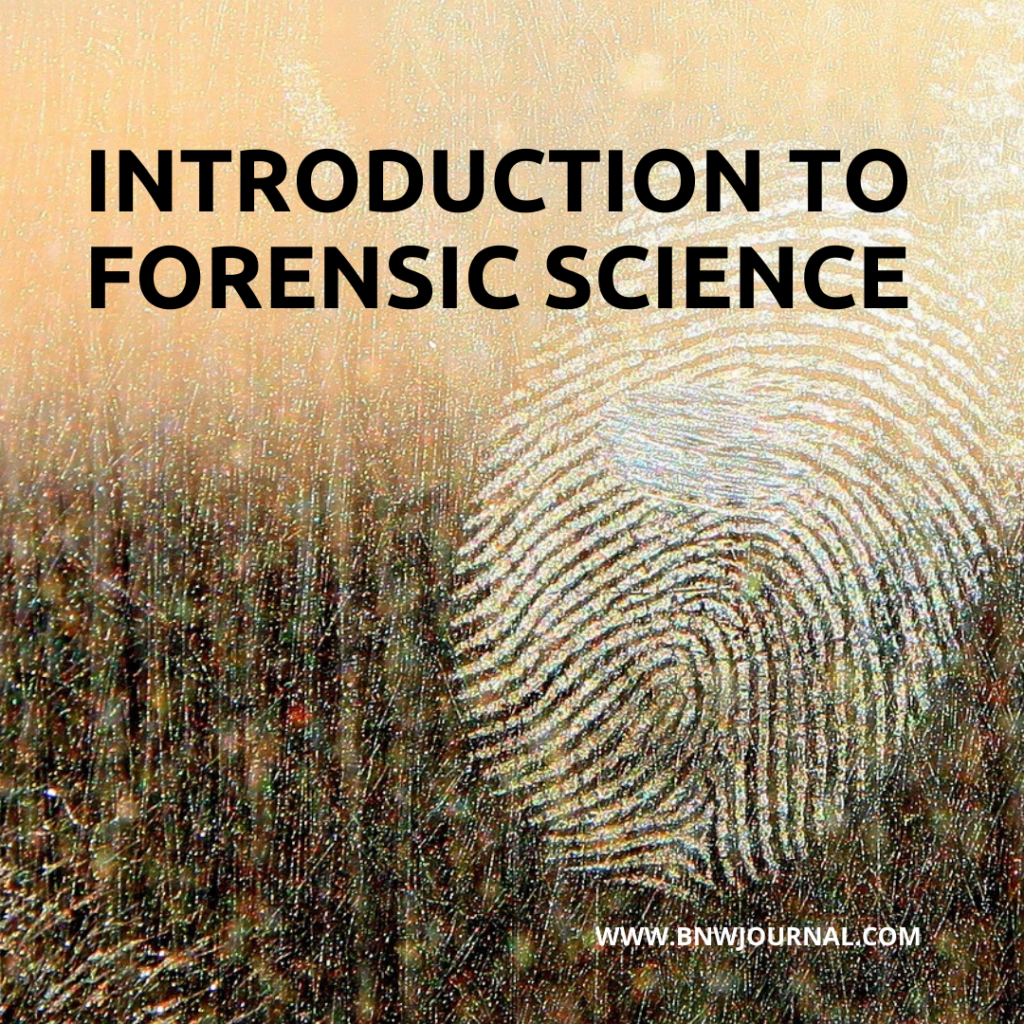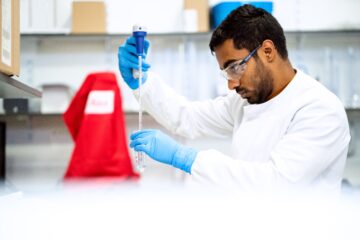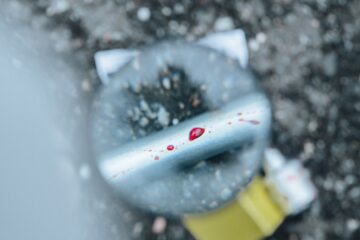![]()
Introduction
The term “forensic” derives from the Latin word “forensics” with means forum. Ages ago in Rome forum meant debate or legal proceedings that are held at public places. This indicated that there has always been a relationship between law and forensic science. It involves the usage of scientific technology in both civil and criminal matters.

Forensic science includes identifying evidence or clues, collecting them, storing them and analyzing them. Since the samples so collected are generally in small quantity, they need proper sampling and storing to avoid contamination. It is a vast field and contains other sciences like Criminology, Anatomy and Toxicology. With the advancement of science and technology, countries now accept forensic science all around the world; it plays a very crucial role in leading the investigation. This article covers the major discoveries in the field of forensic science and its role in the legal aspect.
History of Forensic Science
Forensic science has been adopted in different forms since ages. Back when the concept of Forensic Science was still foreign, people thought deaths occurred for only two reasons. Either due to natural death or due to some mishap. Assumptions were made regarding where the body was found and its state. For example, if there is discovery of a body in water, the cause of death is probably “death via drowning”.
12th century-
Later in the 12th century, Chinese author Sung Tz’u wrote a book named “ The Washing Away of Wrongs” . It focuses on distinguishing between natural or accidental death from one involving criminal intent. He wrote in his book that if a person drowns then water gets collected in the body; but if he dies via choking, then the harm to the cartage on the neck is visible and easier to differentiate.
1800s-
In the 1800s, there was a wide use of the technique of fingerprint. And forensic science became act as an important aspect in a criminal investigation. Such as in the case of Jack the Ripper; who was a serial killer who targeted women prostitutes and he was the first criminal whose documentary was made. Gradually scientist tried to look deeper into this field when back in the year 1775. A chemist named Carl Scheele noticed that when it is possible to convert arsenous oxide into arsenous acid which forms arsine if added along with zinc which is a deadly poison.
Another very crucial discovery was done by the very famous Prof.Mathieu Orfila. He taught at the University of Paris, was given the credit of his efforts of using a microscope to determine fluids like blood and semen. He was later known as the father of Toxicology when he wrote a book named Traite de Poison in 1813. A few years later in 1835, Henery Goddard was successfully able to trace the bullet found in the victim’s body to catch the killer as he noticed the damage in the bullet using which the mould of the bullet that originally has the same flaw was detected.
In 1778, Nathaniel Grew in his book mentions that the ridges, loops, etc present on the fingertips are never the same among any two people. This was observed by many other professors and scientist. Today we call this method of studying fingerprints as discography; and Sir William Hershel is given the credit for this study.
Late 1800s and after that-
Another concept of individual identification came when in the year 1879. Rudolph Virchow observed the distinct character of the hair strand, another aspect of individual identification. In the infamous, Jack the Ripper case, various photographs of the victims were taken to identify the method of killing.
After all the physically discoveries a physiology aspect of crime came up when Edmond Locard. On whom the card principle of exchange is based published a paper in which he wrote that every contract leaves some or the other trace and if those traces are detected then the culprit can be known. Mot only he introduced this principle but also established a laboratory where forensic science was undertaken to resolve crimes. Another very crucial element involved in crime scenes was introduced further in the early 90s. Later Walter Specht takes the credit of developing chemical reagent, named luminal to detect the presence of blood. In the year 1953 another very important discovery in the felid of medical science. The DNA was done by Watson and Kirk. DNA just like fingerprints has a unique identification and was used to identify the criminal.
Principles governing forensic science
Just like other sciences, forensic science has its principles which are as follows-
Principle of Individuality:
It means that every object has certain characteristics which cannot be duplicate. There are chances that a thing may be distinct from another. Thereby using this principle DNA profiling, Retina Scan and fingerprints are used to distinguish between the two people as each human has these completely unique characters.
Principle of Exchange:
Edmund Locard originated this principle according to which whenever two bodies come in contact with each other, there is always some exchange. This principle is very crucial in forensic science as to when the victim’s body comes in contact with that if the culprit then some of the other exchange takes place which could be a strand of hair while fighting, or fingerprints while choking, saliva or sweat, footprints, blood and semen in case of sexual assaults. Once these elements are examine well, the culprit can be identify.
Law of progressive change:
Living objects change with time. The rate of change might differ for example weather changes every day; baby shows both physical and mental changes. This law indicates two main aspects:
The culprit may have physical changes with time. He may grow old, have a beard, he might face some accident which may change him physically
The scene of the crime undergoes various changes. If an accident happens on road after a few days the cars with start running on it, or if the crime scene was a field, grass may grow on it or someone will walk on the ground
Both these aspects indicate that the sooner the investigation proceeds there more chances are that the culprit can be caught and the SOC will not undergo many changes hence time play a crucial role in forensic science.
Principle of Comparison:
It means that comparison can be made among those things which are similar to each other. We can understand this with the help of a certain illustration. If a shot has been fired and bullet recorded was from a short gun then it should be compared with types of short gun and not AK47. If strands of hair that are white are found in victims clothes then comparing it with blonde hair makes no comparison the same way that comparing a handwritten note with a dot pen cannot be compared with a gel pen.
Principle of Analysis:
This principle emphasises on the systematic sampling, storing and analysis of the samples so obtained from the scene of the crime. If the storing of evidence is improper the result will remain inconclusive. If the cloth found in a rape scene which has blood on it and other cloth having semen on it if are stored together will not indicate true results.
Importance of forensic science in a criminal investigation
Forensic investigation plays a major role in criminal cases. It enables the law enforcement teams to garter every scientific or physical element left by the victim or by the culprit on the crime scene. The scene of crime answers the following question
- who were the victim and the culprit
- how did both meet at the scene of the crime
- point of egress and ingress
- when did the incident take place
- the method of crime
- nature of crime
- what all evidence is left behind
- the murder weapon(if left)
- body of the victim (if left)
At times the culprit creates a fake scene of the crime to give the investigation different direction. Whatever evidence is collected from the scene of the crime are sent to the lab for further examinations. Questions are asked from the eyewitnesses and then the outcomes are shown in the judicial proceedings. Every crime has a different nature and the culprit has its method of committing the crime which is also unique. Objects like clothes, wallets, a strand of hair, footprints, fingerprint, hair strand and other body fluids are some key elements. If the clues point towards the accused then he is considered to be the culprit unless the clues were intentionally planted. Scientific techniques like luminous spray, fingerprint analysis, Forensic facial reconstruction, hair analysis. DNA examination are highly advantageous in taking the investigation in the right direction or even catching the culprit.
Does the Indian Legal system approve Forensic Science?
Indian Legal System is not fully in favour of forensic science discoveries as it is not clear as to what extent this methodology is legal and their admissibility in courts.
Indian Constitution
Article 20 which is a fundamental right its sub-clause 3 prohibits any person who has been accused of a crime cannot be forced to act as a witness in contrast if his acts. Hence the accused can’t be tortured to act as a witness against his act.
Article 11 of the Human Right Declaration also states that unless and until the accused is proved not guilty he will not be held accused of any act.
State of Bombay v. Kath Kalu Oghadud and others[1], it was held that giving any sorts of physical evidence like semen, blood, and fingerprints does mean that a person is being a witness against himself. In The Bombay High Court in another significant verdict in the case of, Ramchandra Reddy and Ors. V. The state of Maharashtra[2], it was held that the physiological test like lay detection and P300 testes or narco test can be admissible in the courts.
In, i.e. Selvi & Ors v. State of Karnataka & Anr[3]. In the SC held that tests like ECG, Brain Mapping, Lie detection are not admissible in courts as they lack strong conclusive proves to hold a person guilty.
CPC
The 2005 amendment made in the CPC, 1973, Section 53 of that act held that the accused can be directed to give medical samples of his blood; semen etc if that evidence leads the investigation into the correct direction. But providing of such samples is restrict to only to cases like rape. Such samples cannot be taken in other cases. Sec 164A of CPC,1973 makes it necessary for the women go through medical examination within next 24 hours is she has been sexually assaulted because seem, blood, sweat, finger clippings play a very crucial role in these matters.
Evidence Act
The Evidence Acts considers forensic report as a belief of the expert. The main task of the expert is to present the report in front of the judges. The court frames its own opinion even court is no expert in those matters. At no state of investigating including the trial preceding the accused can be bound for self-incrimination. Section 73 of the Evidence Act allows the courts to demand fingerprints of any person and that that won’t account for self-incrimination.
The National Draft Policy on Criminal Justice Reforms has put up a suggestion that there should be some changes in the evidence act to make the evidence as to more substantive and important ones rather than just stating an opinion on that evidence because they include more scientific backing hence they cannot be completely ignored.
Why the Indian legal system is not well equipped with forensic science?
There could be many reasons as to why India still lags in using criminal investigation techniques. One of the reasons is that the law enforcement officials especially the police are not well equipped with these techniques. They still prefer to use methods which lack the technology and are traditional. In many cases for example ion the Arushi Talwar case it has been observe that the entire scene of the crime was completely tampere by the police force. The neighbours walked past the home transferring evidence from one place to another.
Another important aspect is the collection of samples and if they are not properly store, they either get contaminate or they lose their evidentiary value. The forensic labs in the states are under the control of home ministry and are not independent on their own. The lacked skilled manpower as well as the latest technology and infrastructure. Various committees like the Justice Verma Committee, Malimath Committee, Committee on Draft and National Policy from time to time has emphasized the need of better infrastructure, advanced technology, the introduction of more advanced means of sampling and storing methods. The committees pointes out that the labs are not well equippedto collect DNA samples which play a key role in rape cases.
Case Laws relating to forensic science
Few cases are listed below where forensic science played a very crucial role in identifying the victim or giving direction to the investigation.
- In the case of Vishal Yadav v State of UP[4], the case that involved honour killing where the victim Nitish was burnt by Visual Yadav as he was in a relationship with his sister. One a small part of the hand was found that was burnt and using that DNA examination was done to identify the deceased that helped in the case.
- In Surendra Koli v. State of U.P.[5], in which more than 19 children including an adult was mercilessly killed by Nitish and its servant. The body discovered after a long time and it became difficult to identify the bodies. Therefore the DNA sample was taken from the bones and skulls so that the children who went missing could be identified.
- In the Dr Rajesh Talwar And Another V. Central Bureau Of Investigation[6], where the killing of Arushi and Hemraj took place narco analysis was done on the friends of Hemraj and the postmortem report of both has always been in question.
- Another case where DNA profiling played a major role was Naina Shani Murder Case[7], to identify her half-burned dead body found in the tandoor in which her husband shot her and to dump her body burnt it in a tandoor.
- The Kothkaoi rape case that involved the rape of 16-year-old girl. Forensic science approach gave a big lead to the police as samples of footprints, semen, blood was taken. Those samples were matched with 250 other people to catch the culprit.
Conclusion
It is quite evident that forensic science plays a crucial role in resolving such cases. Keeping in mind, the increase like cases where forensic science plays a crucial role it is time that the Indian Judiciary should give forensic science its due credit. It should accept the evidence provided by forensic rather than relying on the traditional methods of hunting the culprit. Also should use more advanced techniques and take help from experts.
A rough estimation indicated that the prosecution spends approx 10,000 on a trial. It would be simply a waste of tax payer’s money when the culprit is not arrested. The competence of this field is amiable. With the help of DNA proofs, it’s easy to identify that the person who is being accused was even at the scene of crime or not. The expert opinions of the forensic experts should be accepted by the courts. As they hold years of experience Adopting smart ways of resolving investigations gives timely justice and no innocent is put behind the bars. Just like the USA maintains a record of DNA and fingerprints, the same database should be maintained by the Indian government as well.
References:
[1] AIR 1961 SC 1808
[2] 2007, SCC, 296
[3] 2010, SCC 263
[4] 2016 (SCC) 541
[5] (2011) 4 SCC 80
[6] 2013 (82) ACC 303
[7] 2013 (2) SCC 693



0 Comments